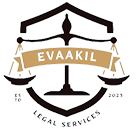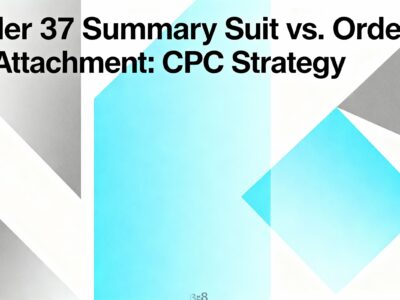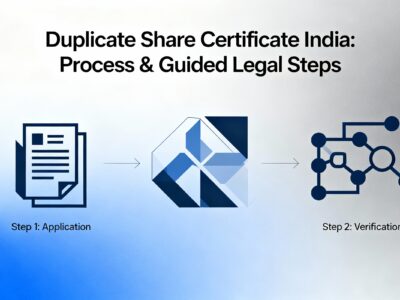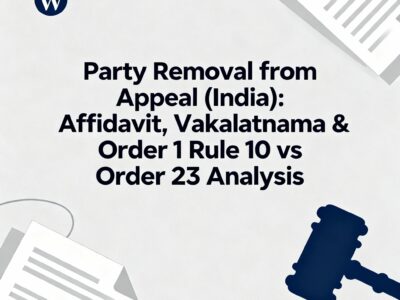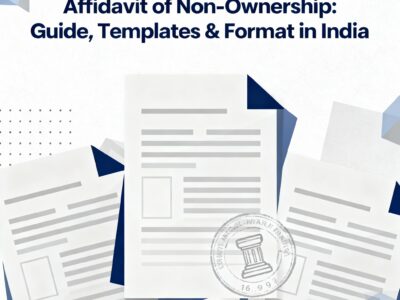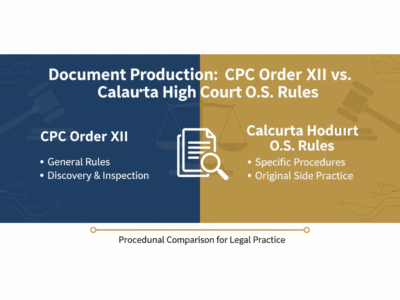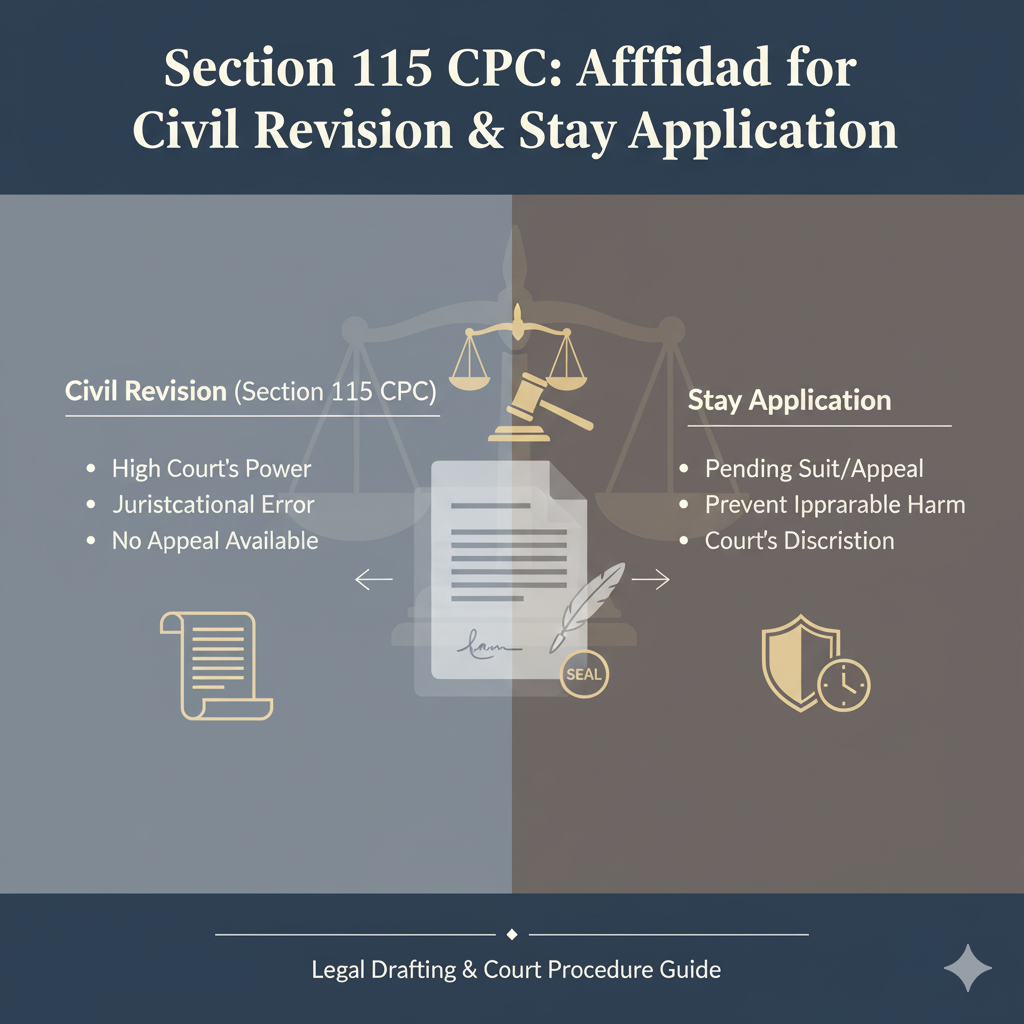A common procedural query in Indian company law is the ‘Affidavit in Support of Summons,’ often mistakenly linked to ‘Rule 404′. This confusion stems from the major procedural shift from the Companies (Court) Rules, 1959, to the National Company Law Tribunal (NCLT) Rules, 2016.
What was once a single document (Form No. 34) under the High Court regime is now a bifurcated process before the NCLT. This guide clarifies this critical procedure, breaking down the roles of Form NCLT. 6 (Affidavit Verifying Petition) and Form NCLT. 7 (Affidavit by Way of Evidence) and comparing them to the historical Form 34 to ensure your company petition is compliant.
'Affidavit in Support of Summons' under Indian Company Law: A Procedural Guide
Debunking the "Rule 404" myth and navigating the shift from the Companies (Court) Rules, 1959, to the NCLT Rules, 2016.
The "Rule 404" Confusion: A Common Procedural Pitfall
A frequent query among practitioners involves finding "Rule 404" for an "Affidavit in support of Summons" under the Indian Companies Act. It's time to set the record straight: this is a procedural misattribution.
The MYTH: "Rule 404"
The "Rule 404" reference originates from the **United States Federal Rules of Evidence (FRE)**. It governs the (in)admissibility of character evidence ("Other Crimes, Wrongs, or Acts") and has absolutely no relevance to Indian company law procedures.
The REALITY: Two Frameworks
The correct procedure is found in two distinct Indian legal regimes:
- Historical: The Companies (Court) Rules, 1959
- Modern: The National Company Law Tribunal (NCLT) Rules, 2016
This guide will provide a comprehensive "translation" of the procedures, moving from the historical High Court regime to the current NCLT framework.
The Great Procedural Shift: 1956 to 2016
Understanding the affidavit procedure requires understanding the evolution of company law adjudication in India. The jurisdiction has completely shifted from the High Courts to the National Company Law Tribunal (NCLT).
The Companies Act, 1956
The foundational legislation governing companies in India for decades.
The Companies (Court) Rules, 1959
The procedural code for company matters filed before the **High Courts**.
The Companies Act, 2013
A new, modern Act that replaces the 1956 Act and conceives of a new tribunal system.
The NCLT Rules, 2016
The new, unified procedural code for all company matters filed before the **NCLT**.
The Single Most Critical Change: Bifurcation of Affidavits
The old 1959 Rules combined verification and evidence into a single document. The new 2016 NCLT Rules separate them. This is the most common procedural error. Failing to file both affidavits will delay your petition.
THEN: Companies (Court) Rules, 1959
(Affidavit in Support of Summons)
Attested to the truth of the summons.
Contained all the facts and justification.
NOW: NCLT Rules, 2016
(Verification Affidavit)
(Evidentiary Affidavit)
Attests to the truth of the petition.
Contains all facts, justifications, and annexures.
The Historical Regime: Companies (Court) Rules, 1959
The phrase "Affidavit in support of Summons" comes from **Rule 67** of the 1959 Rules, which pointed to **Form No. 34**. This single document served as both the verifying affidavit and the primary evidentiary document for a "Summons for Directions" (e.g., for a scheme of arrangement).
Note: These rules are not purely historical. Per Section 434 of the Companies Act, 2013, certain "grandfathered" winding-up cases still pending before a High Court **must** continue to follow the 1959 Rules.
The Modern Regime: NCLT Rules, 2016
In the NCLT, "Summons" is replaced by "Notice" (Form NCLT. 5) and the initiating document is a "Petition" (Form NCLT. 1). As the infographic above shows, the affidavit function is bifurcated:
- Pillar 1 (Verification): Rule 34(4) mandates that every petition must be verified by an affidavit in Form No. NCLT. 6.
- Pillar 2 (Evidence): Rule 39(3) states that all evidence is to be given by affidavit in Form No. NCLT. 7.
The Core Purpose: The "Summons for Directions"
The historical "Summons for Directions" (and its modern NCLT petition equivalent) is the procedural heart of any scheme of arrangement, compromise, or reduction of share capital. The *entire purpose* of Form 34 (or its NCLT. 7 counterpart) is to provide the Court/Tribunal with enough preliminary evidence to justify ordering meetings of shareholders and creditors.
It's an Application for Permission
You are not asking the Tribunal to approve the final scheme at this stage. You are asking for permission to *convene the meetings* that will vote on the scheme. The affidavit must provide all the necessary information for the Tribunal to set the meeting's parameters, including:
- Who should be invited to vote (the "classes" of members/creditors).
- How they should be notified (the "directions" for publication).
- Who will oversee the meeting (the "appointment of a Chairman").
Procedural Showdown: High Court (1959) vs. NCLT (2016)
Use the filters to compare the old and new procedural regimes side-by-side.
| Feature | Companies (Court) Rules, 1959 (High Court) | NCLT Rules, 2016 (Tribunal) |
|---|---|---|
| Primary Legislation | Companies Act, 1956 | Companies Act, 2013 |
| Adjudicatory Body | High Court | National Company Law Tribunal (NCLT) |
| Initiating Document | "Summons for Directions" | "Petition" or "Application" (Form NCLT. 1) |
| Document to Respondent | "Judge's Summons" | "Notice" (Form NCLT. 5) |
| Purpose of Affidavit(s) | Combined (Verification + Evidence) in Form No. 34. | Bifurcated (Separate). |
| 1. Verification Affidavit | Rule 21 (General) or part of Form No. 34. | Form No. NCLT. 6 (Mandatory per Rule 34) |
| 2. Evidentiary Affidavit | Contained within Form No. 34. | Form No. NCLT. 7 (Substantive evidence per Rule 39) |
Deconstructing the Evidentiary Affidavit (NCLT. 7)
The NCLT. 7 affidavit (which contains the substance of the old Form 34) is not just a formality; it is the entire factual basis for your application. It must persuasively contain all the elements required by the NCLT Rules and the original Form 34's logic.
Key Contents of Your NCLT. 7 Affidavit
-
1. The Circumstances (The "Why"):
You must set out, in clear paragraphs, the circumstances that necessitate the arrangement. (e.g., "The company has incurred losses...", "A strategic merger is proposed...", "The capital structure is inefficient..."). This is the factual foundation.
-
2. The Objects (The "What"):
What is the goal of the scheme? (e.g., "To restructure the debt...", "To absorb the business of the transferor company...").
-
3. The Classes of Stakeholders (The "Who"):
This is a critical part. You must precisely identify the different classes of shareholders (e.g., Equity, Preference) and creditors (e.g., Secured, Unsecured, Trade) whose rights are affected. The Tribunal will order separate meetings for each distinct class.
-
4. The Effect of the Scheme:
A transparent explanation of the scheme's impact on all stakeholders, including any potential prejudice.
-
5. Proposed Directions (The "How"):
You must *suggest* the directions you want the Tribunal to issue. This includes:
- The proposed date, time, and venue for the meetings.
- The name of the proposed Chairman for the meetings.
- The newspapers in which you propose to publish the meeting notices.
- The timeline for sending notices to individual stakeholders.
Annotated Legal Formats (Interactive)
Select a template below to see the annotated legal format. These are for illustrative purposes and must be adapted by a qualified legal professional.
Template A: (Historical) Affidavit in Support of Summons
Basis: Form No. 34, Companies (Court) Rules, 1959.
Context: Used for a Summons for Directions in the High Court. Still applicable for "grandfathered" cases.
IN THE HIGH COURT AT [City]
(Original Jurisdiction)
IN THE MATTER OF THE COMPANIES ACT, 1956
AND
IN THE MATTER OF [Name of Company Limited]
Company Application No. ……… of 20…….
AFFIDAVIT IN SUPPORT OF SUMMONS
I, [Name], son of [Father's Name], aged about [Age] years, residing at [Address], do solemnly affirm and say as follows:
1. I am the [Managing Director/Secretary] of [Name of Company Limited] ("the said Company") and am duly authorised... to make this affidavit.
Annotation: Establishes the deponent's legal authority to speak for the company.
2. The Registered Office of the Company is situated at [Address].
3. The present authorised share capital of the Company is Rs. [Amount]...
Annotation: Clauses 2-3 provide the company's essential corporate information.
4. The document now shown to me and marked as Exhibit 'A' is a true copy of the Memorandum and Articles of Association.
5. (Set out a detailed summary of the "circumstances necessitating the compromise or arrangement.")
Annotation: This is the evidentiary core, explaining *why* the Court's intervention is required.
6. A proposed scheme of compromise/arrangement is attached hereto and marked as Exhibit 'B'.
Annotation: This clause formally introduces the scheme as required by Rule 67.
7. It is prayed that this Hon'ble Court may be pleased to issue directions for:
(a) Convening the respective meetings of the [Stakeholders]...
(b) Appointing a Chairman for each of the said meetings.
(c) Directing the publication of notices...
Annotation: This is the "Prayer for Directions," the ultimate purpose of the summons.
DEPONENT
VERIFICATION
...
Final Checklist for a New NCLT Filing
Use this actionable checklist to ensure your new petition is procedurally compliant.
- Draft Main Application (Form NCLT. 1).
- Draft Verification Affidavit (Form NCLT. 6).
- Draft Evidentiary Affidavit (Form NCLT. 7) with all annexures.
- Prepare Ancillary Documents (Index, Synopsis, Dates & Events).
- File the complete set in triplicate with the NCLT Registry.
- Serve the issued Notice (NCLT. 5) and the complete set on all respondents.
- File the "Affidavit of Service" with the Registry as proof.
The Next Step: The Affidavit of Service
Filing the NCLT. 6 and NCLT. 7 affidavits gets you the *first* order (the directions for convening meetings). Once the NCLT issues those directions, you must execute them (publish notices, send mailers, etc.).
Your *next* crucial filing is the "Affidavit of Service."
What is an Affidavit of Service?
This is a new affidavit, filed *after* the meeting notices have been sent, in which the deponent (usually the Company Secretary or Director) swears to the Tribunal that all its directions for service and publication have been followed to the letter.
You will annex copies of newspaper clippings, postal receipts, and courier reports as exhibits. Filing this affidavit proves to the Tribunal that all stakeholders were properly notified, allowing the meetings to proceed validly.
Frequently Asked Questions (FAQ)
Who can be a deponent for these affidavits?
The deponent must be a person who is:
- A key managerial person (KMP) like a Director, Managing Director, or Company Secretary.
- An officer of the company.
- Duly authorized by a Board Resolution to make the affidavit on the company's behalf.
What happens if I make a mistake in my affidavit?
Procedural errors (like incorrect paragraph numbers in NCLT. 6) or factual errors can be serious. If an error is discovered, the standard practice is to seek the Tribunal's permission (by filing an interim application) to place a supplementary or "further affidavit" on record to correct the mistake. Do not simply file a new one; you must seek leave of the NCLT.
Can I combine the NCLT. 6 and NCLT. 7 affidavits?
No. This is the most common procedural error. The NCLT Rules explicitly bifurcate the two functions. The NCLT. 6 is a *verifying* affidavit for the main petition and has a specific format. The NCLT. 7 is the *evidentiary* affidavit containing the facts and annexures. You must file them as two separate, distinct documents.
